 777 020 090
777 020 090 Types of handling techniques
Types of handling techniquesFront forklifts are an auxiliary force in material handling, and these seated forklifts are probably the most widely used industrial forklifts.
Depending on the type of environment in which forklifts are used, a number of their modifications result. They are divided, for example, according to the drive used, type of construction, load capacity and other special or additional equipment.
.jpg)
The front forklift truck is divided according to the type of drive into trucks with an internal combustion engine or a battery drive.
Forklifts with an internal combustion engine are further divided according to the type of fuel used. Diesel forklifts are available, which are among the most widely used handling technology. The second group of vehicles with internal combustion engines are gas or LPG forklifts. Trolleys of this type are a versatile helper when working both indoors and outdoors. Gas forklifts can be further modified to operate on CNG fuel, which further reduces emissions and extends the life of the pressure vessel.
Battery - electrics forklifts, or electric lifts, are a solution especially for operation in an enclosed space, where it is necessary to reduce the amount of emissions. The electric motor, which is used in the battery truck, is powered by a traction or Li-ion battery, which also serves as a counterweight. Electric wheelchairs are available in 3-4 wheels. Thanks to the modernization of the battery, it is possible to use the truck even in temperatures falling well below freezing, down to -30 ° C. This is especially suitable for operation in a refrigerated environment. In our offer are available electric-lift up to 8.5 tons.
Another group can be "special" forklifts, ie trucks that are not so versatile, but are necessary for certain types of operations. We can include in this group, for example, heavy-duty forklift trucks, where their load capacity reaches up to 48 tons. It is used for handling very heavy or bulky loads such as shipping containers. The most suitable for transporting long loads is a side-loading truck or a four-way lift, which allows handling in four directions without the need to turn the entire truck.
Rack stackers are designed exclusively for rack warehouses. They are adapted to either the handling of storage boxes, pallets, bar material or manual picking. The rack stackers are formed by a carriage and a vertical column, along which the picking device moves - possibly also with the operator's cab.
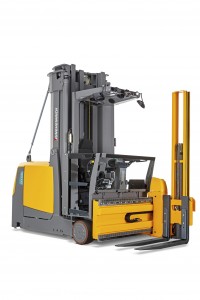
High-lift stackers are suitable for full automation of warehouse processes. Automated rack stackers move horizontally along a track located on the floor or ceiling of a warehouse. When using both tracks at the same time, it is possible to perform operations up to heights of 40 m, work with great accuracy and safety even at high operating speeds in very narrow aisles up to 1,800 mm.
Some manufacturers generally refer to rack stackers, system trucks, VNA trucks, three-way stackers, and stackers.
In the picture you can see the Jungheinrich stacker.
Reach trucks are VZV with retractable lifting equipment, which are used for handling loads in places with limited space. Reach trucks are supplied with AC and DC drive. Despite the fact that the reach trucks have a three-wheel chassis, they are characterized by high stability, which allows loading up to 13 meters.
(2).jpg)
The operator sits sideways to the direction of travel, which guarantees them a sufficient view and also comfort, for example when reversing. The four-way variant is adapted to the narrow spaces, which usually has electronically controlled control of all wheels, which rotate in all directions and allow the truck to turn on the spot.
System trucks, VNA (Very Narrow Aisle) trucks, or trolleys for three-sided loading, are various designations for trucks that are designed for picking and pallet handling in very narrow aisles. Man-down trucks are designed for fast side pallet handling and Man-up trucks are designed for handling entire pallets and high-level picking in very narrow aisles. Instead of the entire truck, a rotating three-sided loading head rotates in the aisle, thanks to which the pallet can be placed on either side of the aisle. Thanks to this feature and the maximum lift height, which is up to 14.8 m for these trucks, the storage space can be used more optimally. The requirement for perfect floor evenness is also associated with a very high lift height. Local uneven floors in the floor of a few millimeters could cause static mast tilt, stability problems and endanger the safety of the truck.
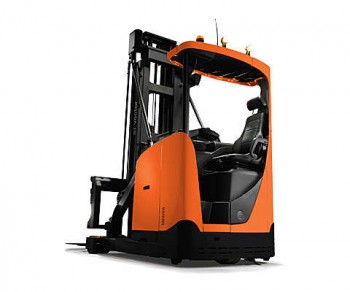
The width of the normal handling aisle, which is intended for direct travel, especially of front forklift trucks with a counterweight, is determined according to the largest width of the operated handling truck, resp. mobile handling equipment, or the maximum width of the handling unit (load) being moved, to which a safety clearance on each side of at least 200 mm shall be added. For the front VZV, the minimum working aisle width is set at 1,900 mm. The trolley for very narrow aisles according to the model and type of construction is able to work in aisles with a width of 1,400 mm.
In the picture you can see the Toyota VNA.
Picking trolleys are not primarily intended for the transport of loads, although horizontal picking trolleys can also be used for the transport of entire pallets. These special VZVs are used for picking goods to / from the racks, where the picked goods and the user standing on the platform are lifted at the same time, thus providing the operator with immediate access to the material in the racks or on the forks.
The basic division is into horizontal picking trucks, which are designed for picking from the ground, possibly in combination with the first above-ground level, and vertical picking trucks, which are used for assembling pallets from above-ground levels. Picking trolleys according to picking levels are divided into
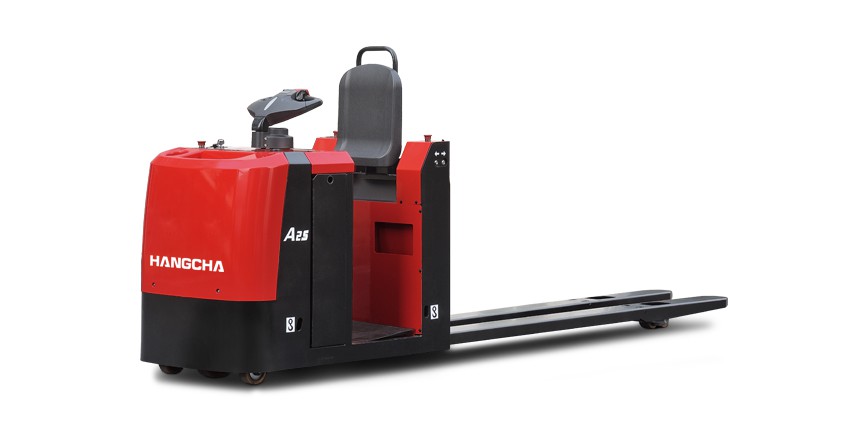
low level (<2,500 mm), medium level (2,500 - 6,000 mm) and high level (<12,000 mm). Machines with forks with a length of 2,400 mm are designed for picking two pallets at once.
Picking trolleys are designed only for handling on paved areas, inside halls and inside cargo spaces. Ensuring a quality floor without local unevenness is essential for high-level trucks to ensure safety and stability.
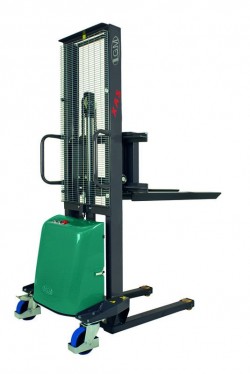
Stacking is the safe stacking of handling units. Stacking of handling units is usually performed by fork handling, most often using VZV with a vertical mast without the possibility of tilting it. Stacking trucks are suitable for various types of load handling, such as stacking loads, loading and unloading loads from trucks, from the ground, on handling ramps and platforms, and horizontal transport of loads on flat surfaces. The trucks are designed for low or medium stacking heights (<6,000 mm).
Depending on the length of the transport distance, the stacking trolleys offer versions with walking operator (for short distances), models with a driver's platform, with standing or sitting operator. The latter two types offer faster travel for faster distances (up to 9.5 km / h).
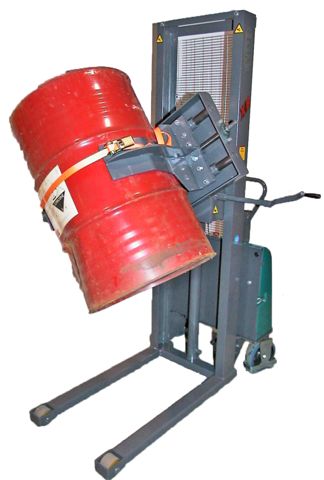
Hand-held VZVs and low-lift trucks (hereinafter NZV) trucks are suitable for operations with limited handling space for their small radius of action. Thanks to their dimensions, these trucks have greater maneuverability and much lower acquisition and operating costs. However, their operation is limited to indoor areas with a flat and solid surface.
Manual light VZV / NZV for walking operators or with a platform for a standing driver are suitable for light use. Manual VZV / NZV are designed for seated distances and for demanding use in the warehouse. standing, service.
Manual VZV / NZV are available on the market in many variants that fully meet the purpose of their use. For example:
VZV / NZV with arm lift has wheel arm lifting independently of the forks for easy overcoming of uneven terrain, ramps or loading bridges,
stainless steel, resp. galvanized VZV / NZV for corrosive or aggressive environments,
step-by-step VZV with adjustable fork width is ideal for handling special pallets or for handling loads wherethe ground clearance is low,
extended load-bearing legs in VZV with a wide track allow the transport of atypical loads,
VZV with double stroke are designed for handling two pallets at the same time,
22
variants of trolleys for transport and tipping of barrels, etc.
The disadvantage of VZV / NZV lies in the construction of their forks, which makes it impossible to pick up standard pallets in width.
The massive expansion of palletization was also helped to a large extent by the use of an internationally dimensionally uniform pallet with dimensions of 800 x 1,200 mm, resp. halved pallets 600 x 800 mm. Today, however, attention is focused on ISO-compliant pallets with dimensions of 1,000 x 1,200 mm and smaller EUROPALLETS with dimensions of 800 x 1,000 mm.
The pallet truck is used to move pallets and is an essential tool for simplifying pallet handling. The hand pallet truck (RPV) is designed to lift the load, which is achieved by pumping the drawbar, to a height sufficient to transport the load. Because RPVs are not powered by any engine, their operating and maintenance costs are minimal. Electric pallet
trolleys fall into the category of hand-held VZV (see above). 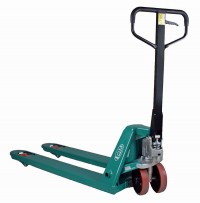
RPV is produced in many variants and processes, eg:
electric pallet trucks designed for occasional loading, resp. unloading,
RPV for display pallets,
RPV with scale for accurate load weighing,
scissor RPV with lifting table function for better operator ergonomics,
stainless steel, resp. galvanized RPV for corrosive or aggressive environments.
Tractors are three-wheeled or four-wheeled motor trucks designed for moving non-motorized trucks (trailers). Tractors are primarily designed to develop traction, but some types have a platform for transporting cargo. Tractors allow towing palletized i
non-palletized loads and are suitable for indoor and outdoor operations. The steering is operated by a tiller or steering wheel. For lighter operations, electric tractors are available in a three-wheel variant, the four-wheel variant is designed for more demanding operations. The tractors are equipped with internal combustion engines for the most demanding operations. Depending on the length of the transported distance, manual tractors and tractors with a seated or standing driver are available.
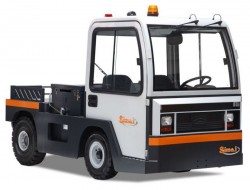
Modern innovative systems include an automatic tractor. Automated guidance systems perform a similar type of handling function as mechanized tractors with a trailer. The important difference is that the system does not require an operator and is automatically routed to the destination without operator intervention.
It is possible to connect various types of roller trucks behind the tractor, including shelf, platform or bale models.